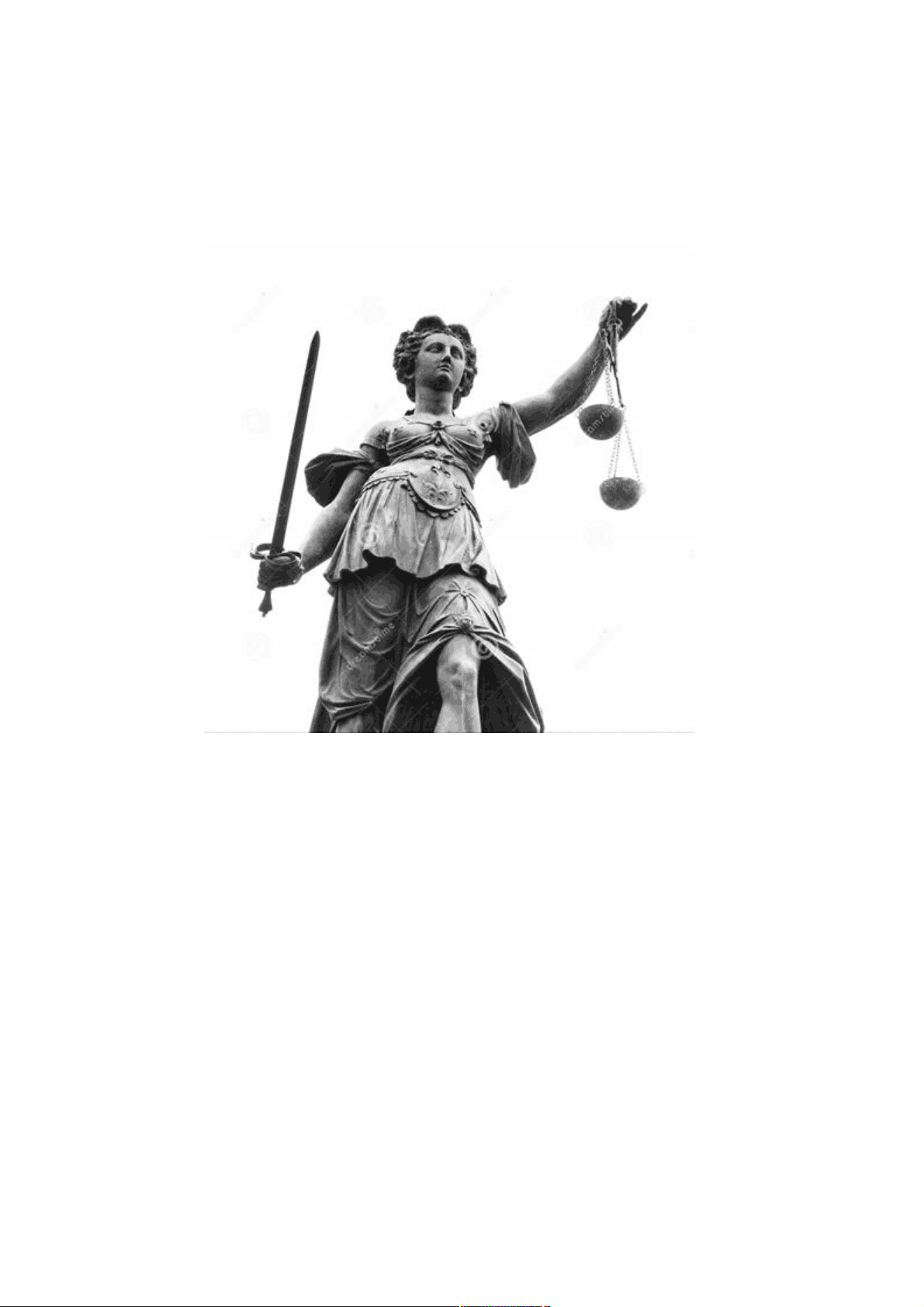
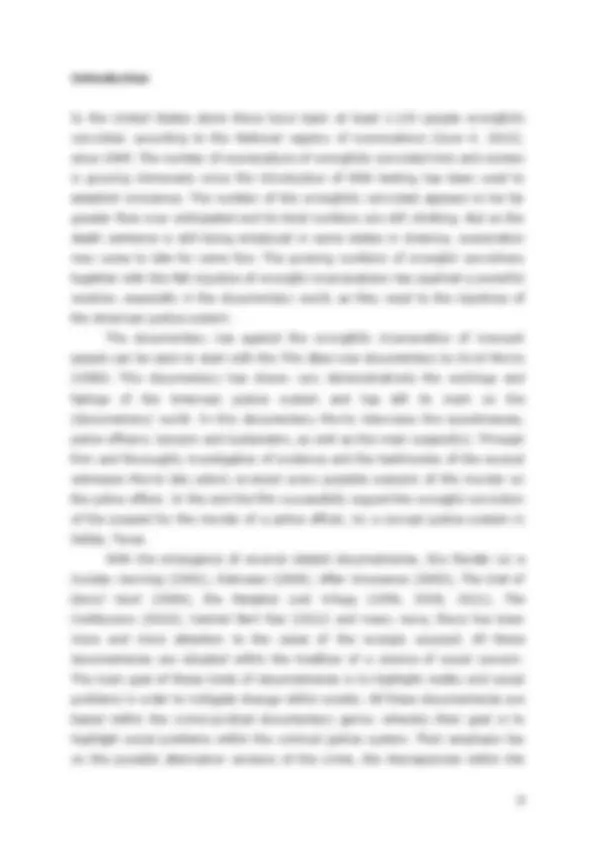
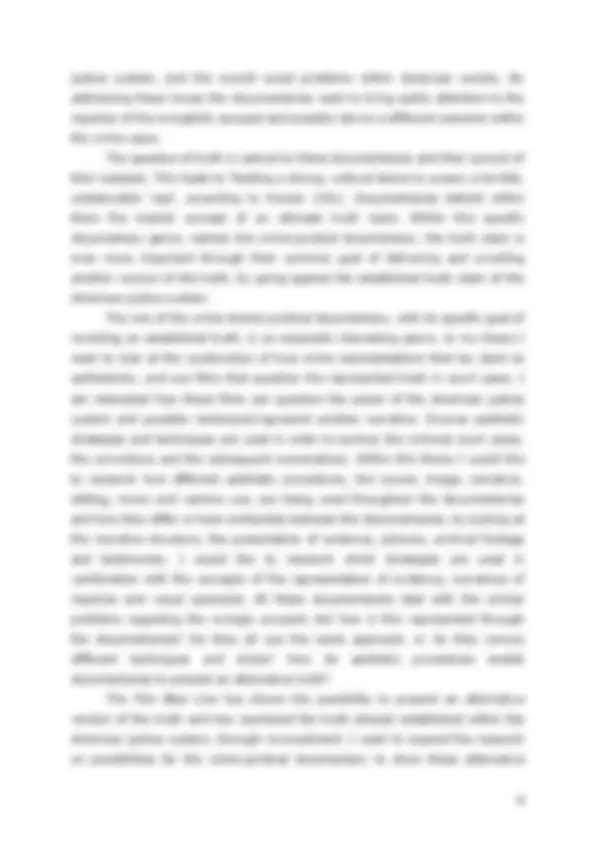
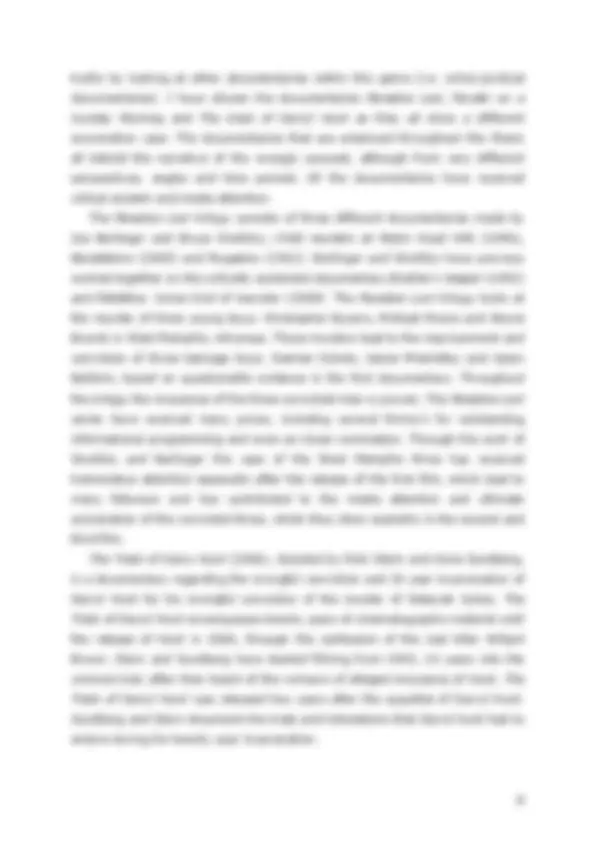
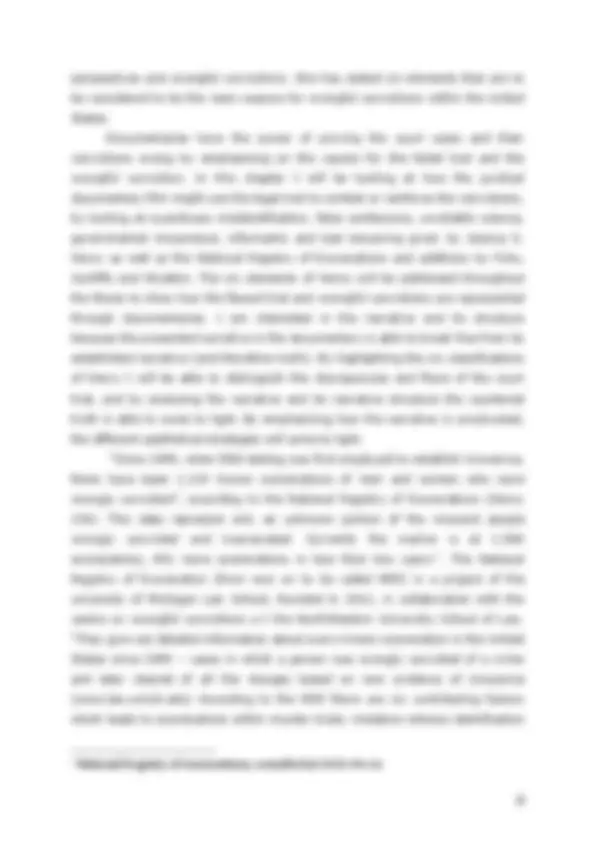
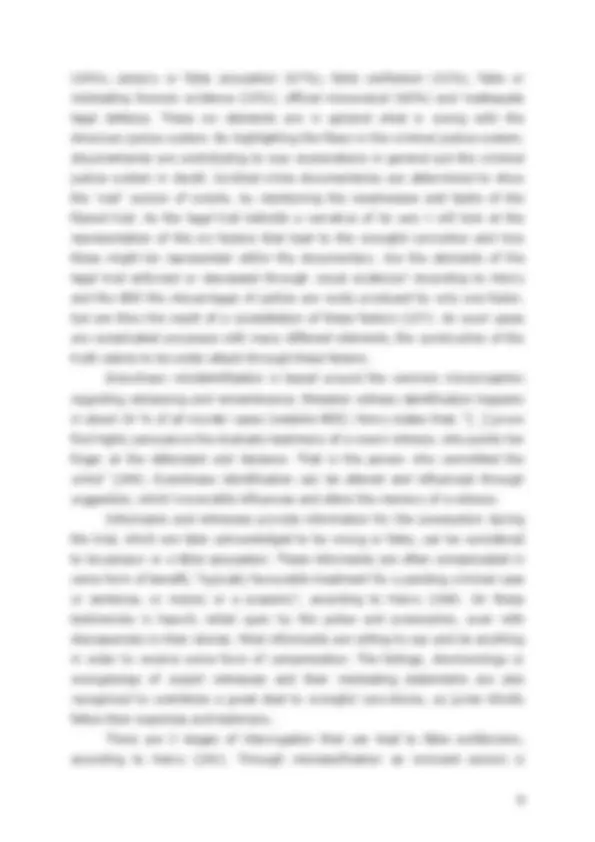
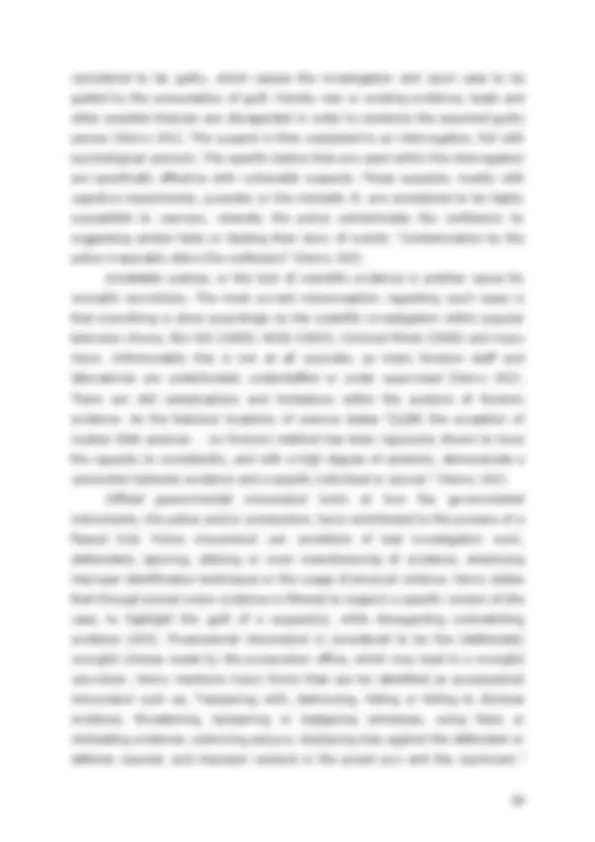
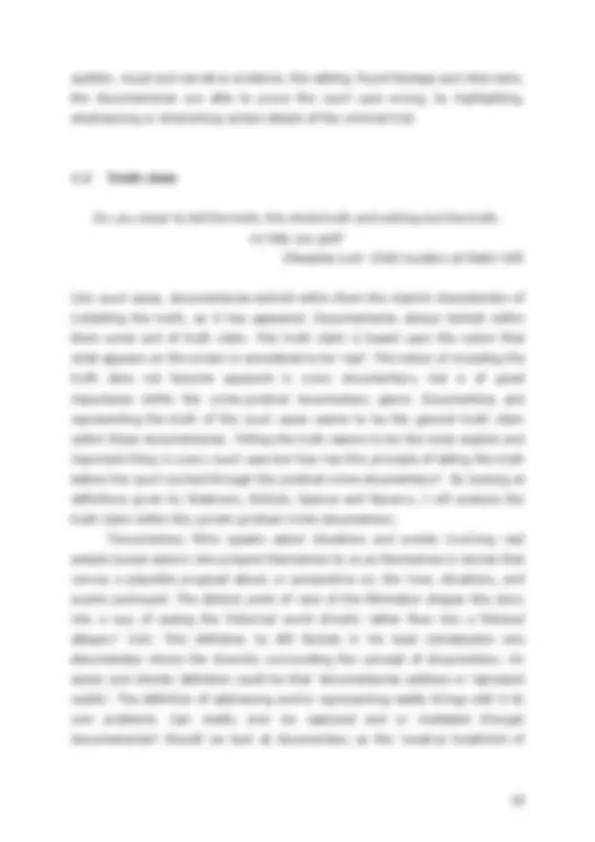
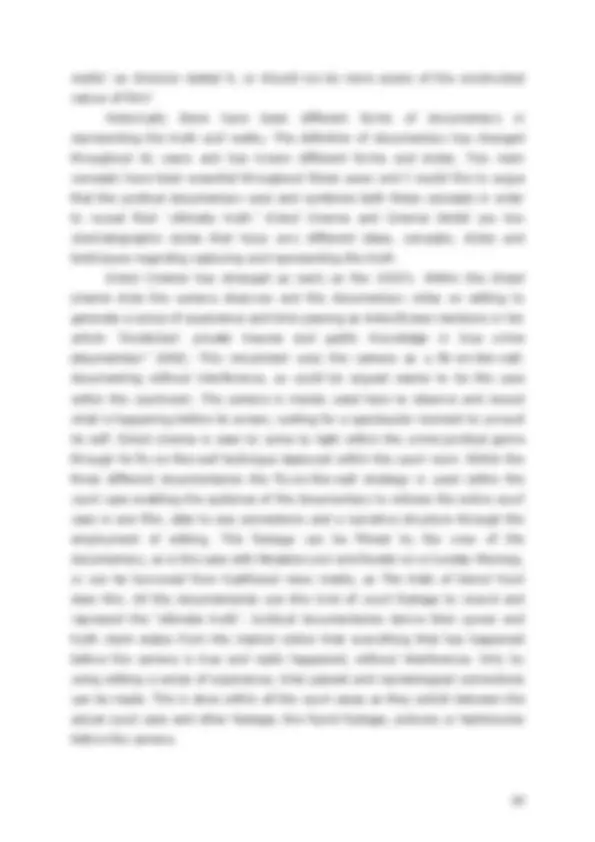
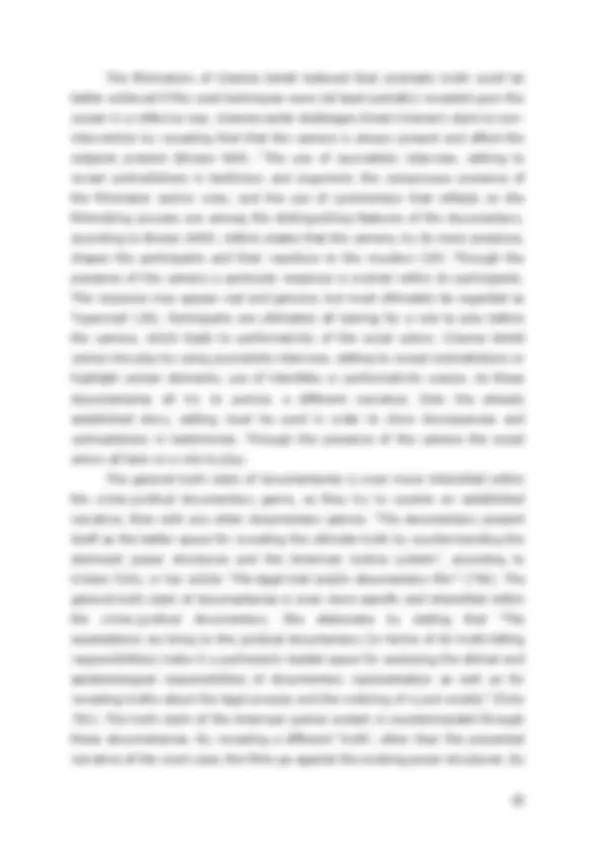
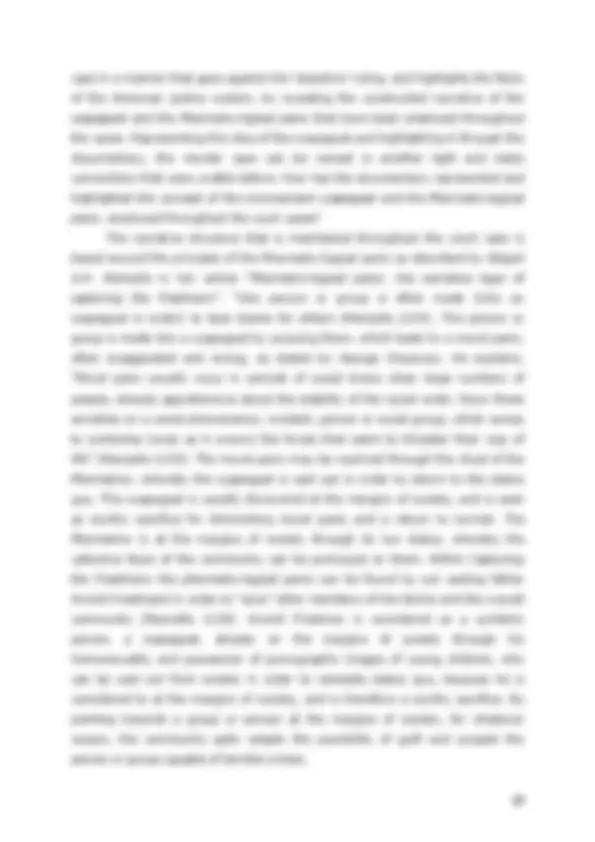
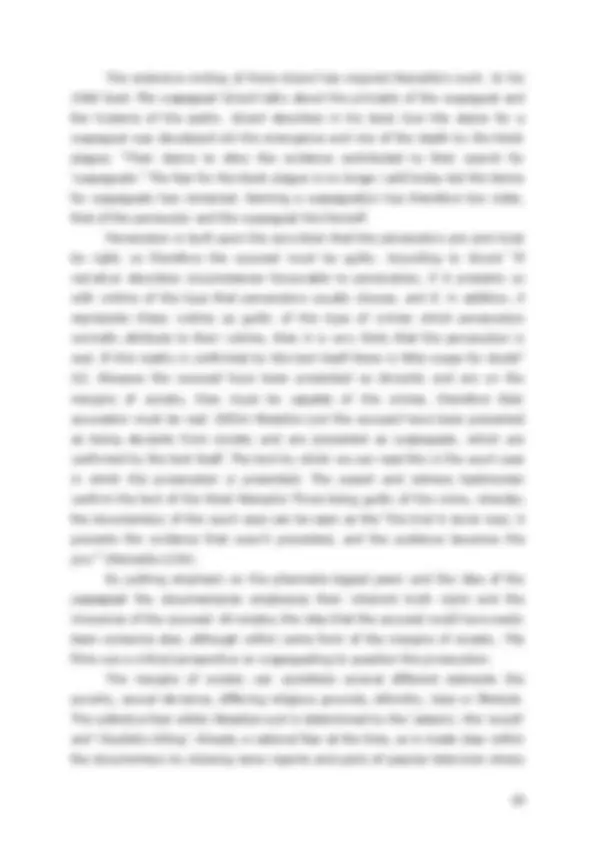
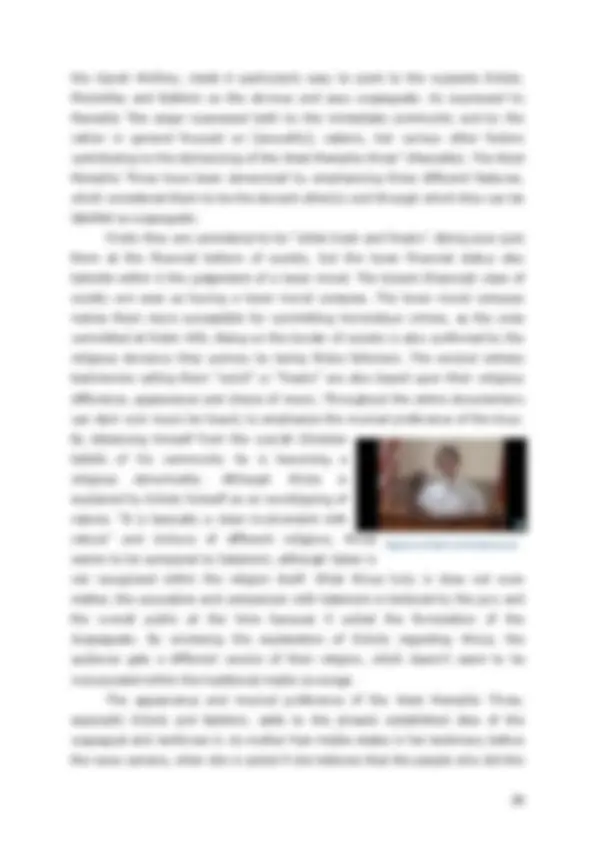
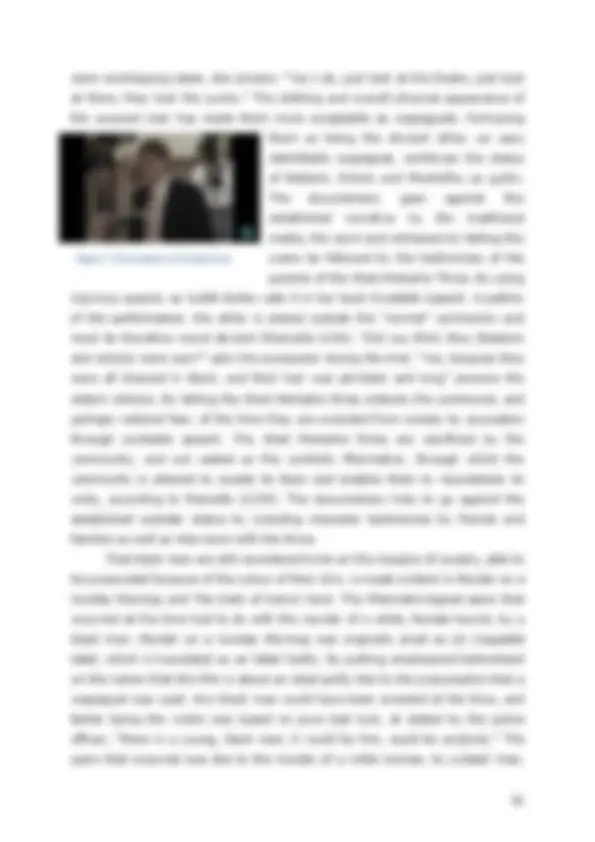
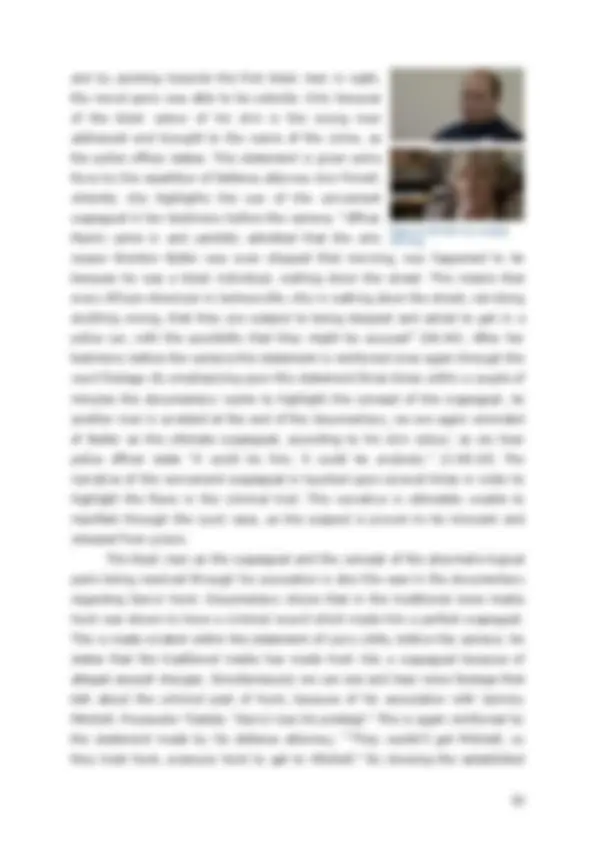
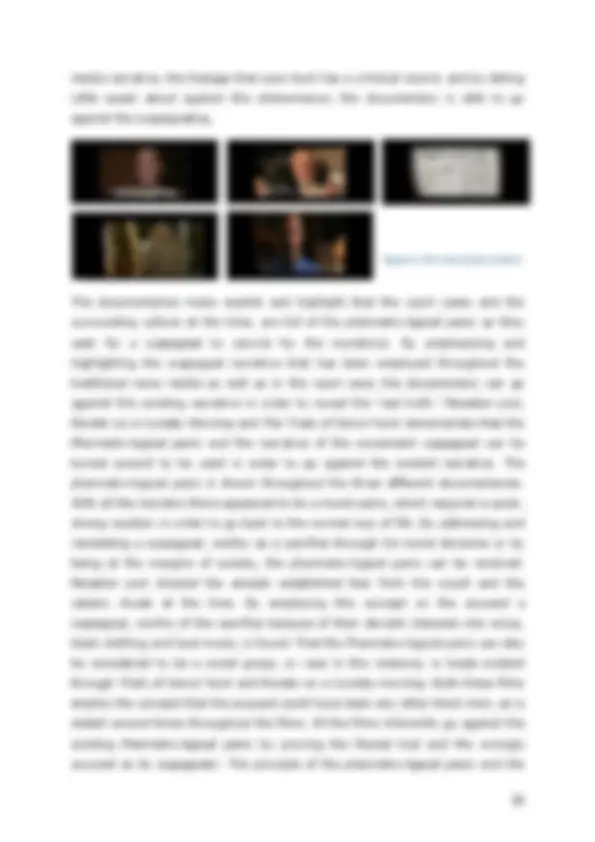
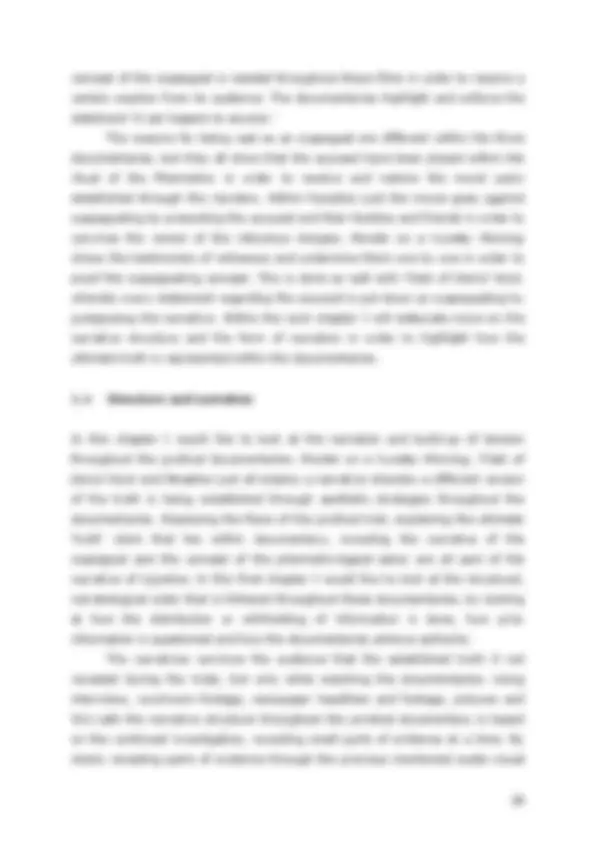
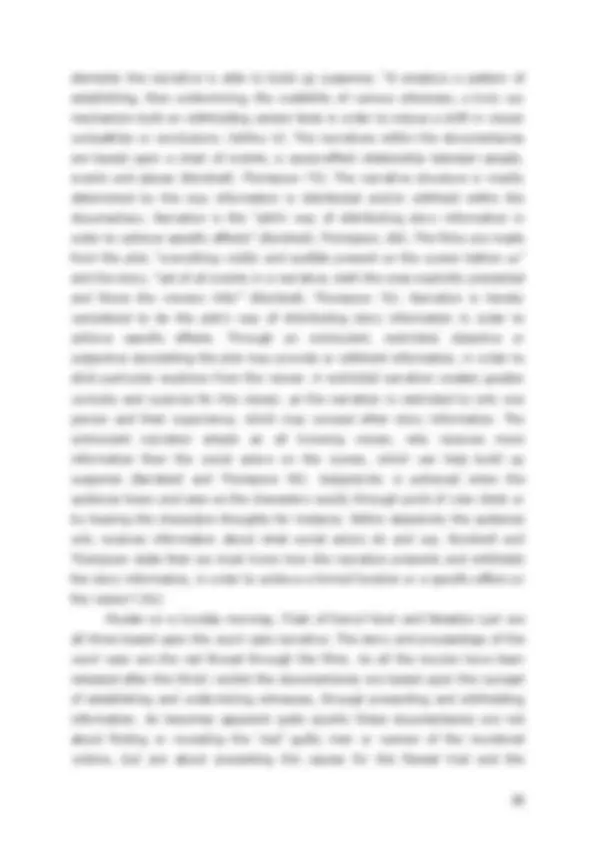
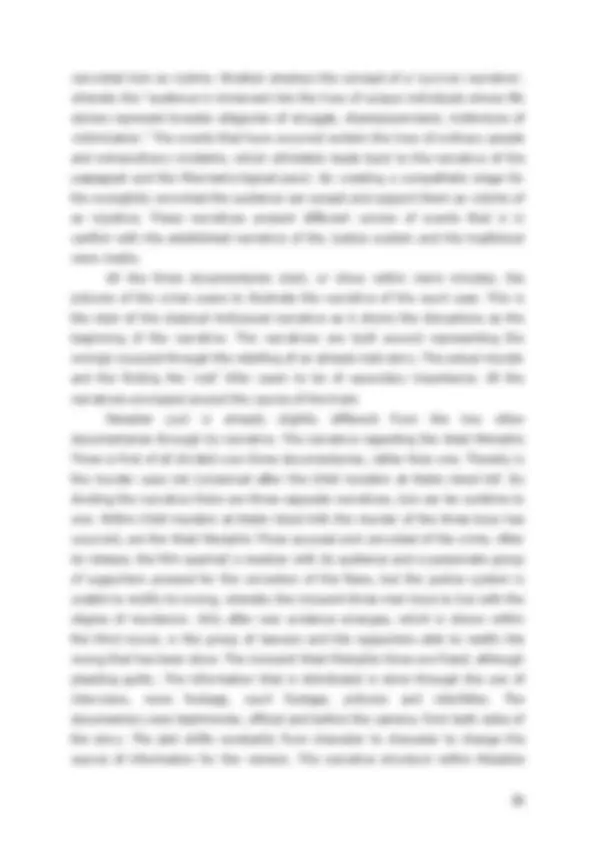
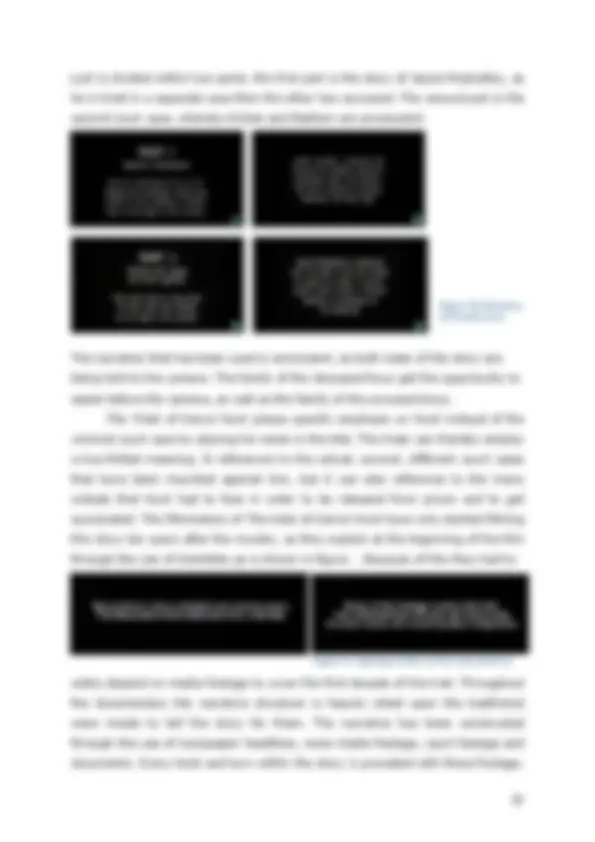
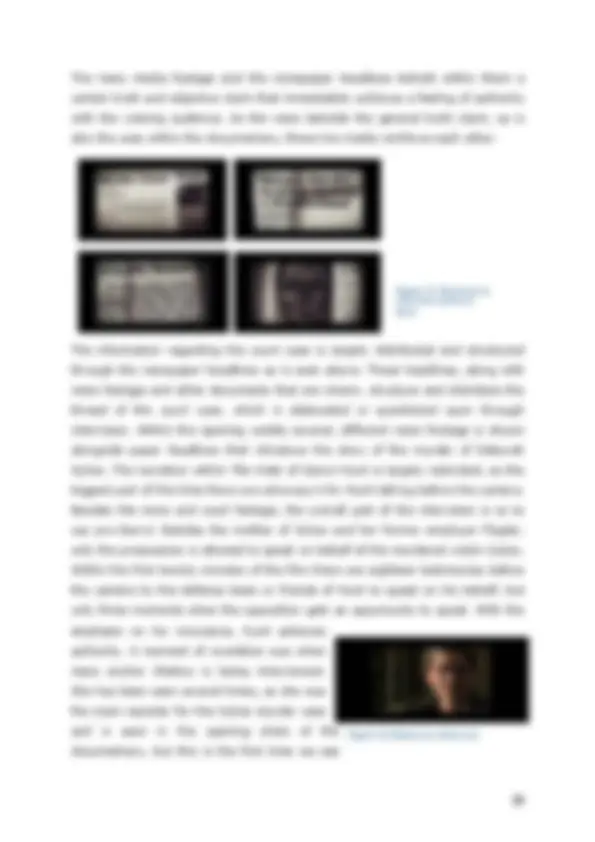
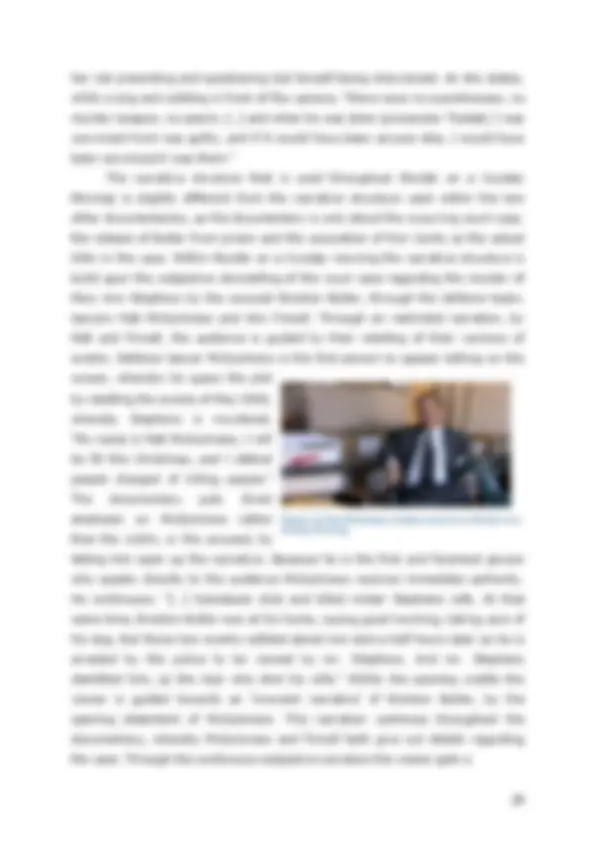
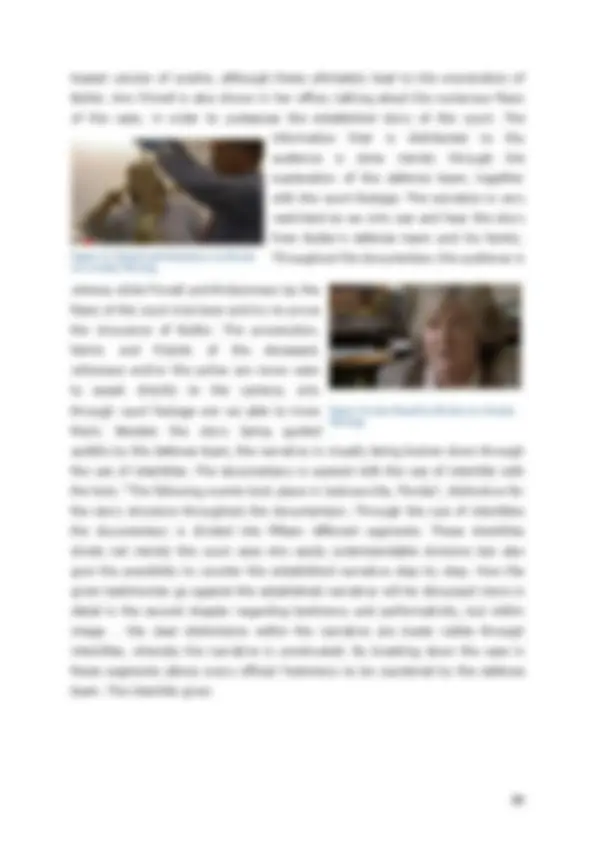
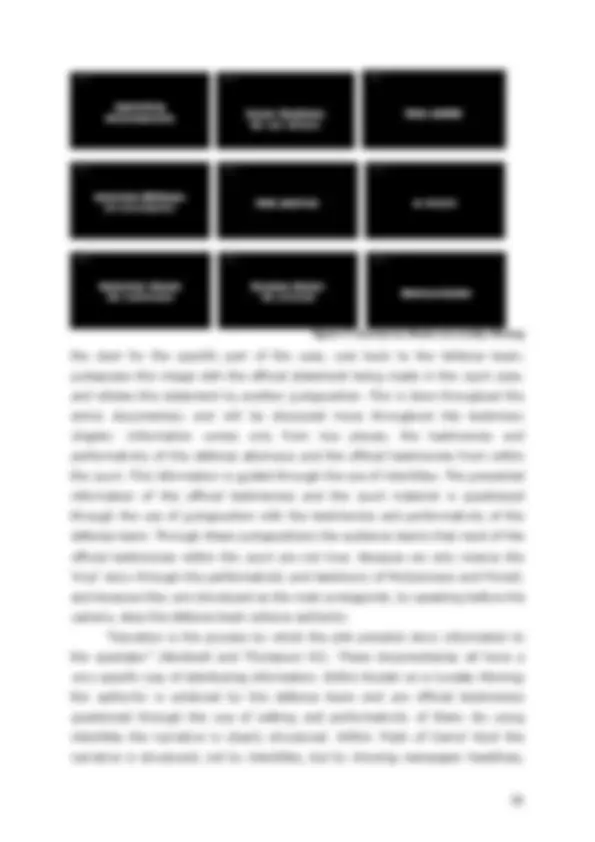
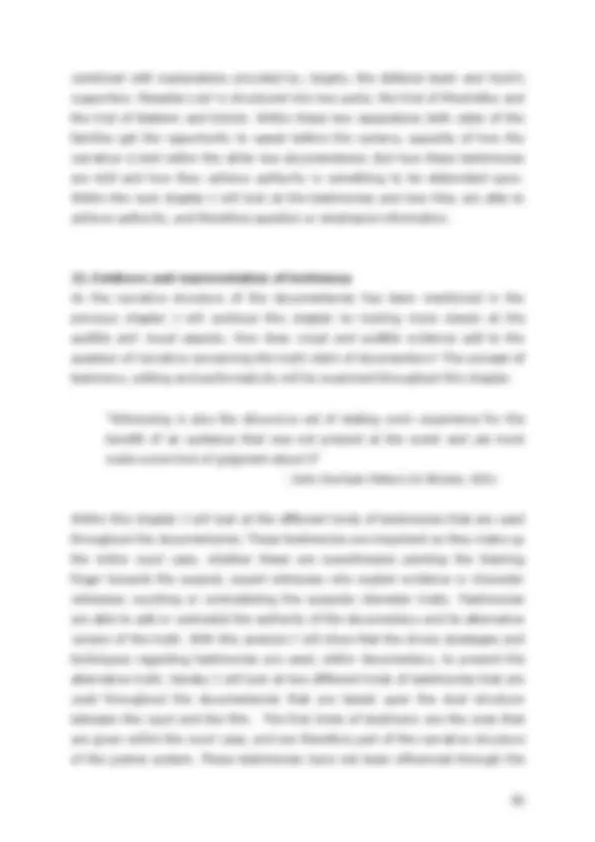
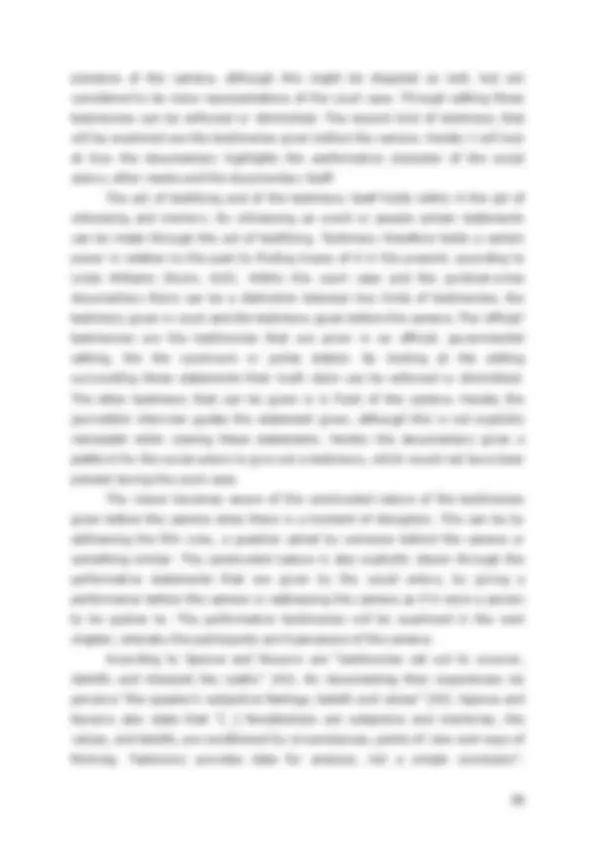
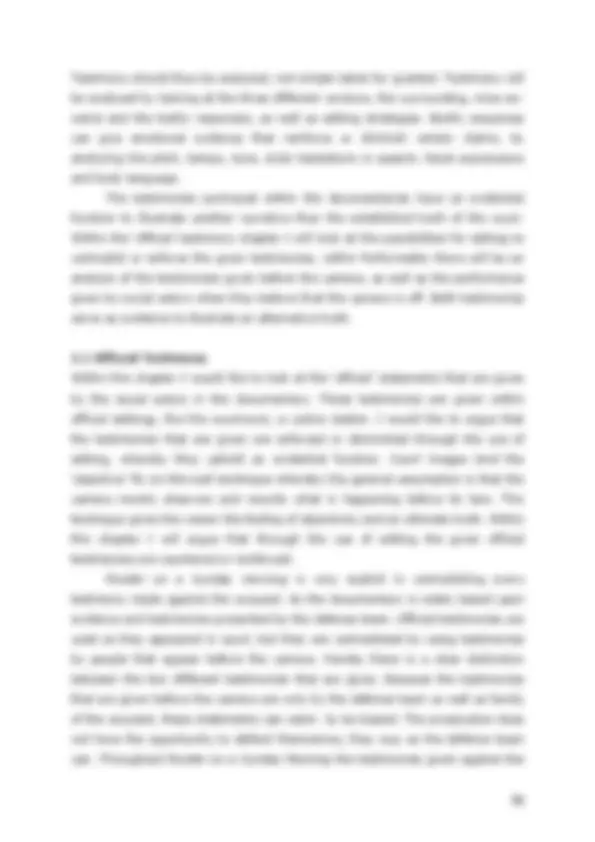
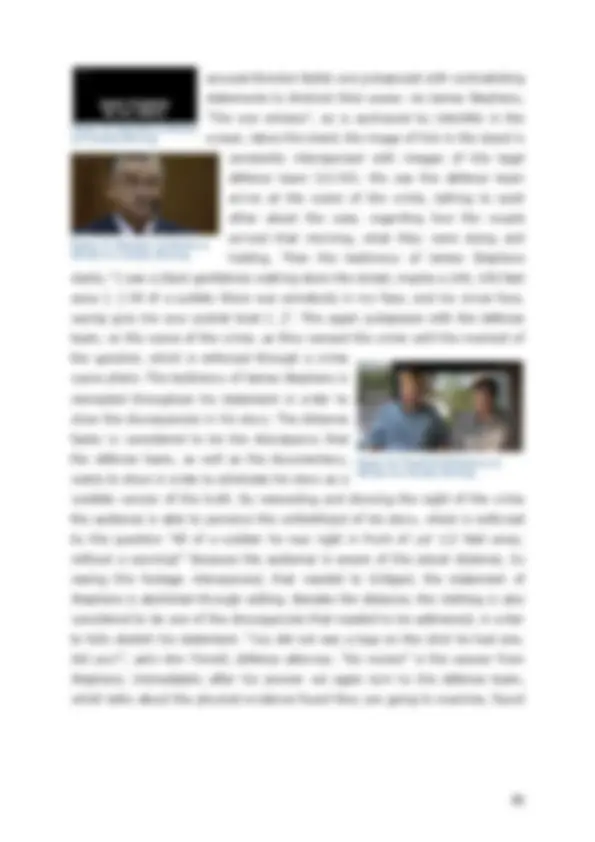
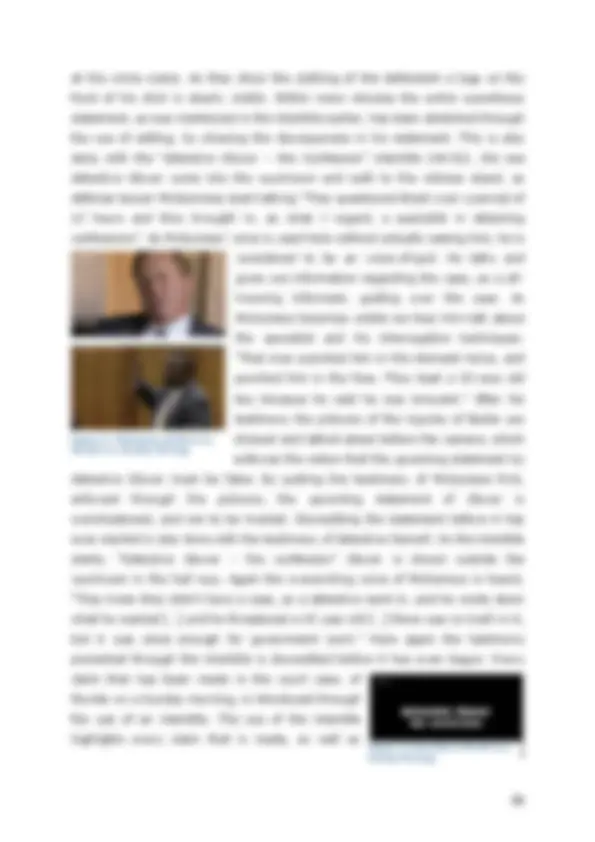
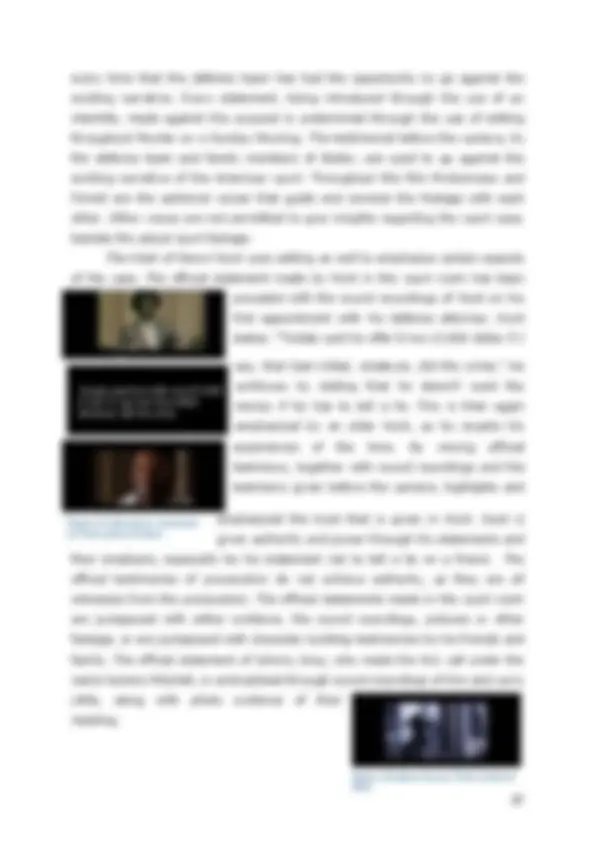
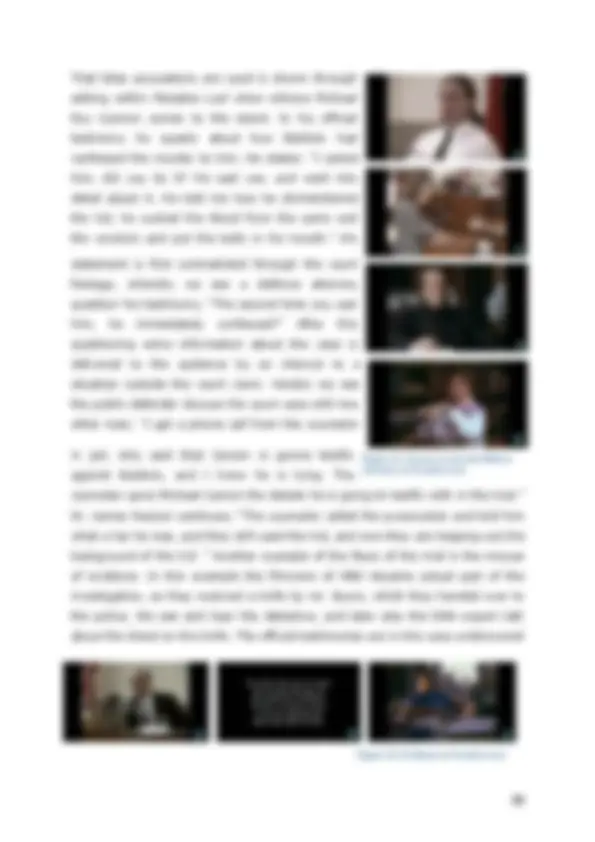
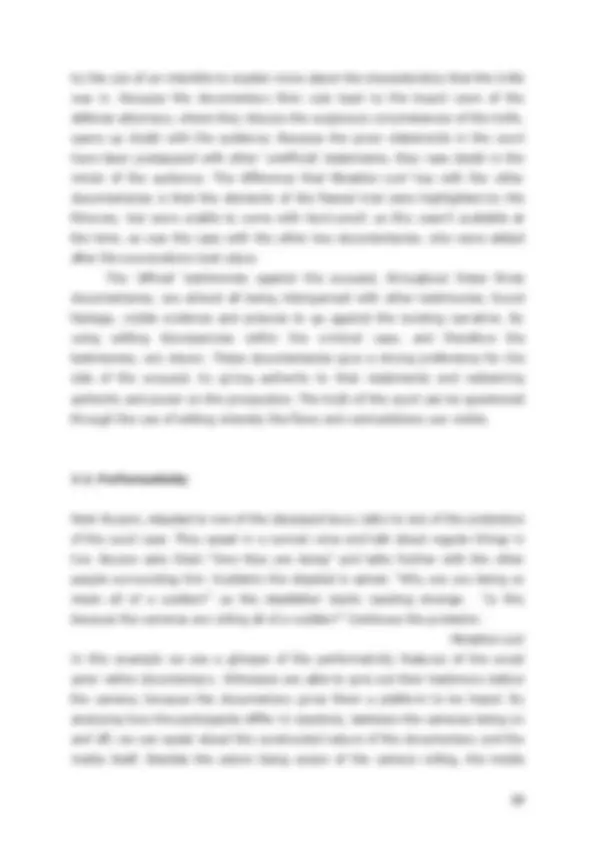
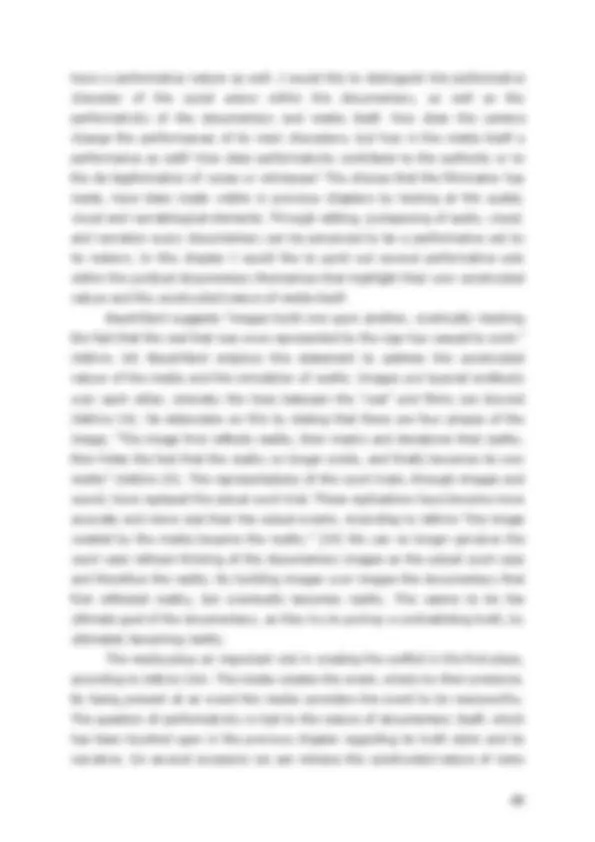
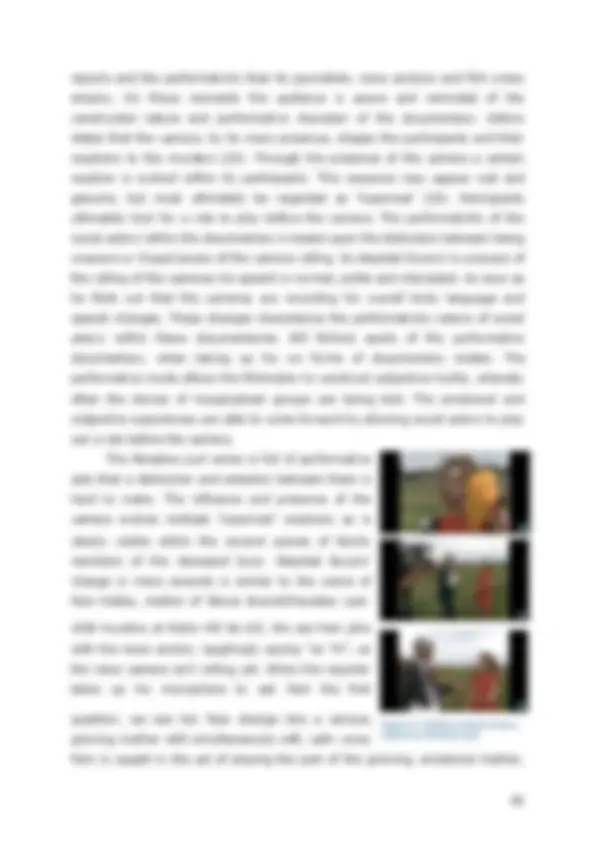
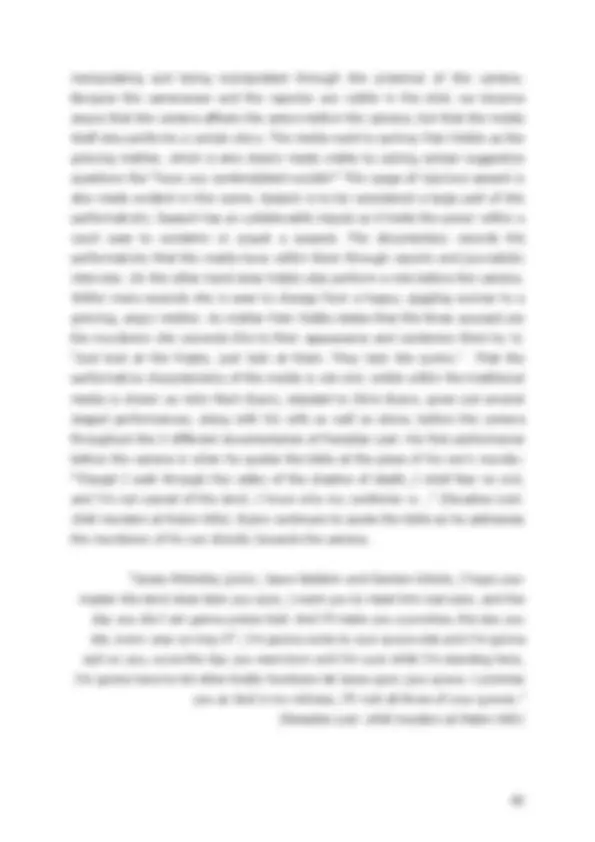
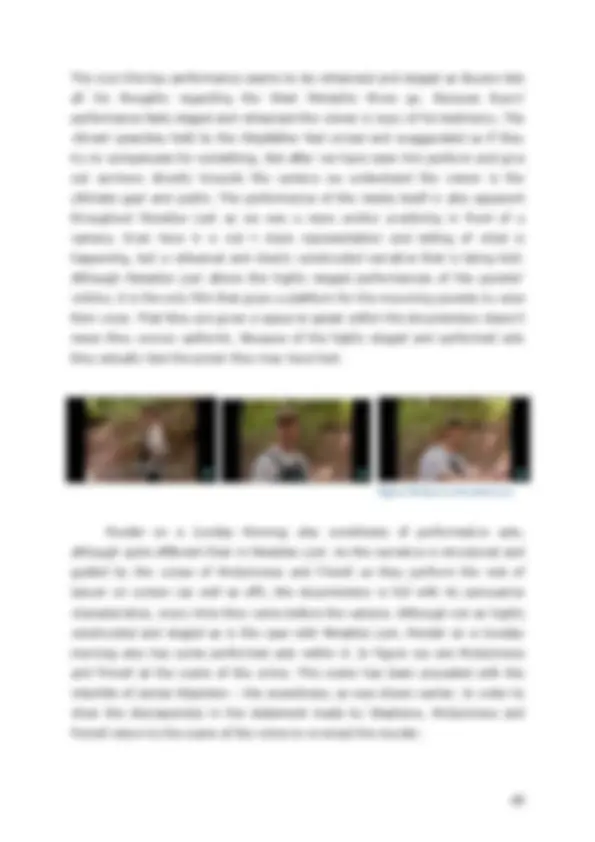
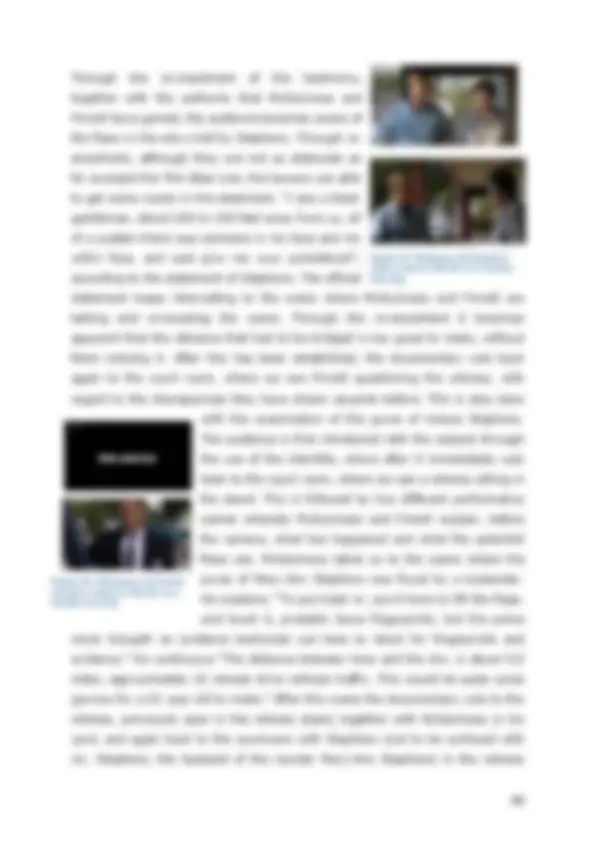
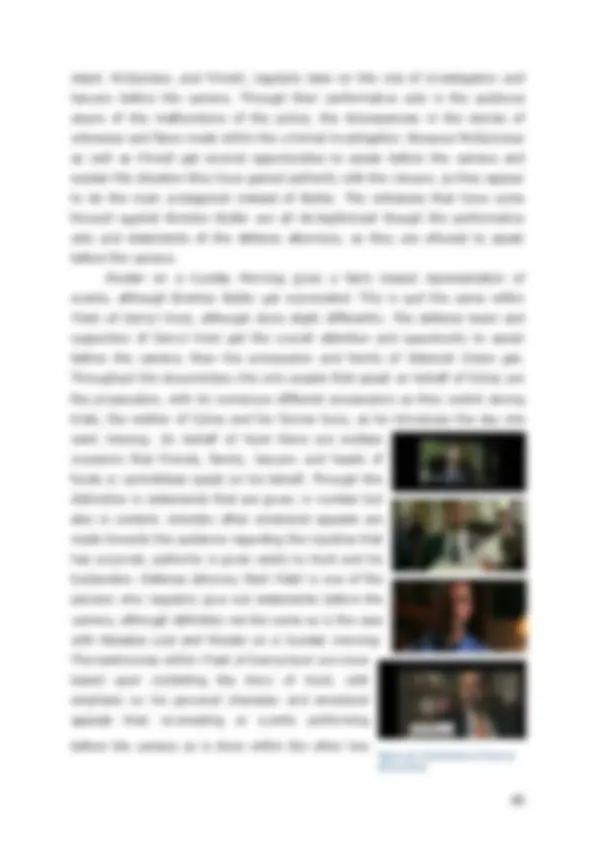
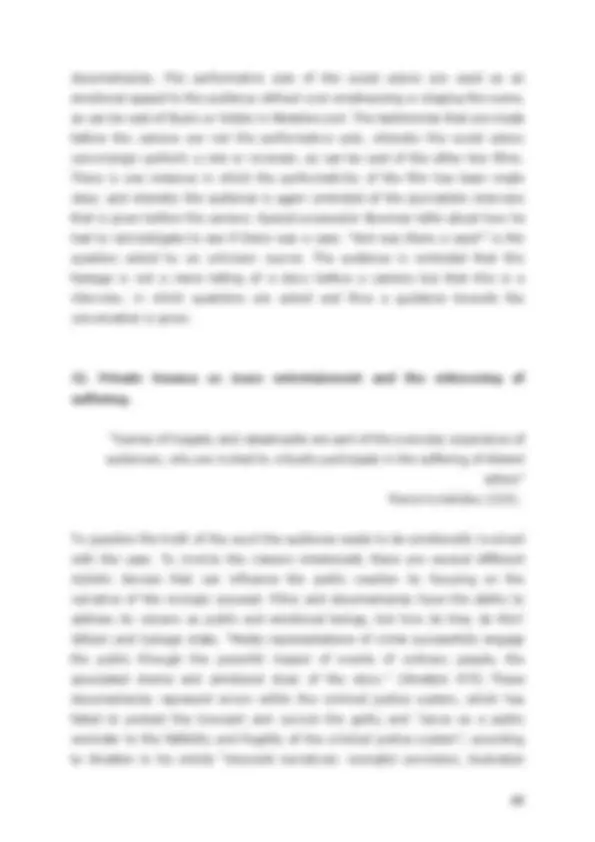
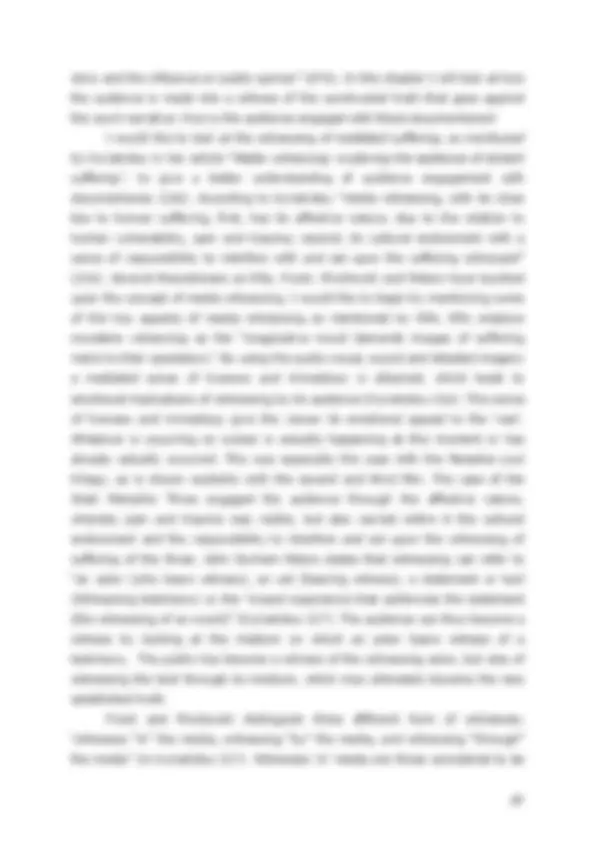
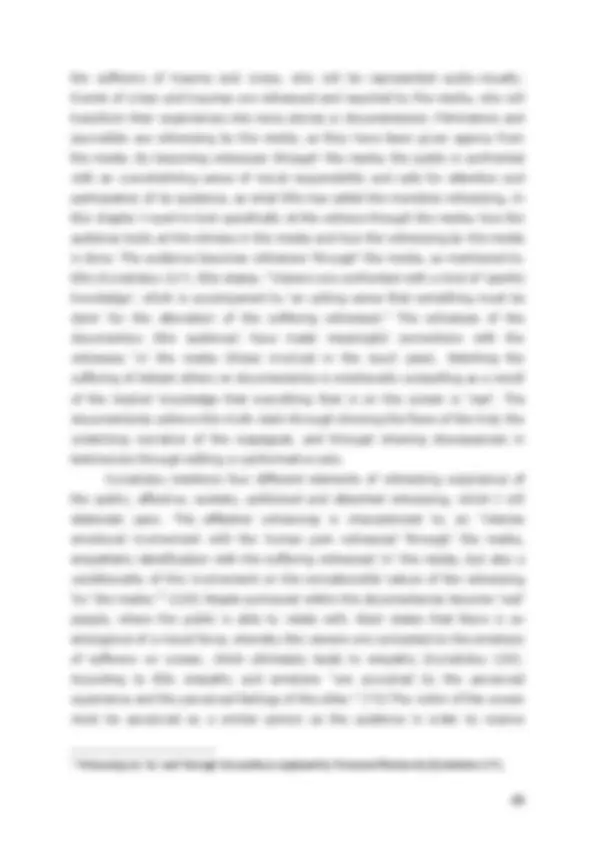
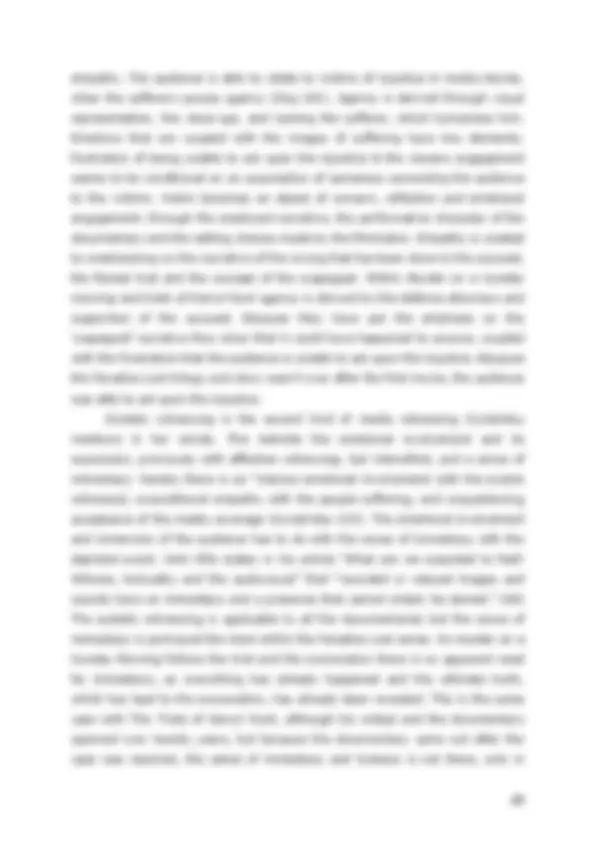
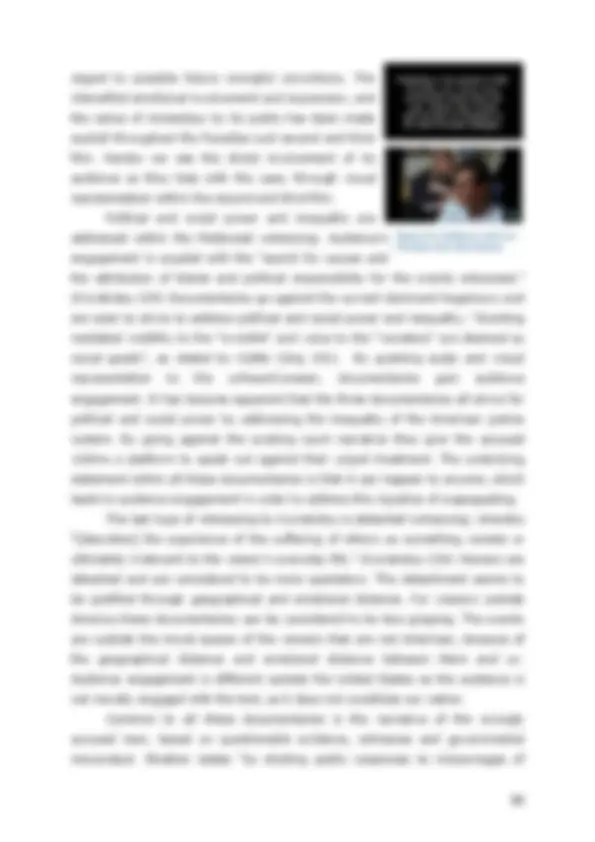
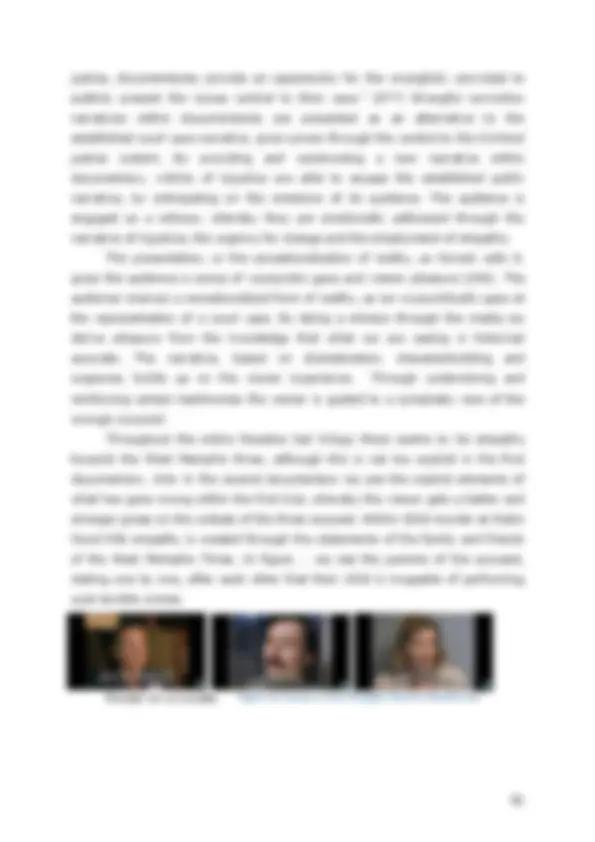
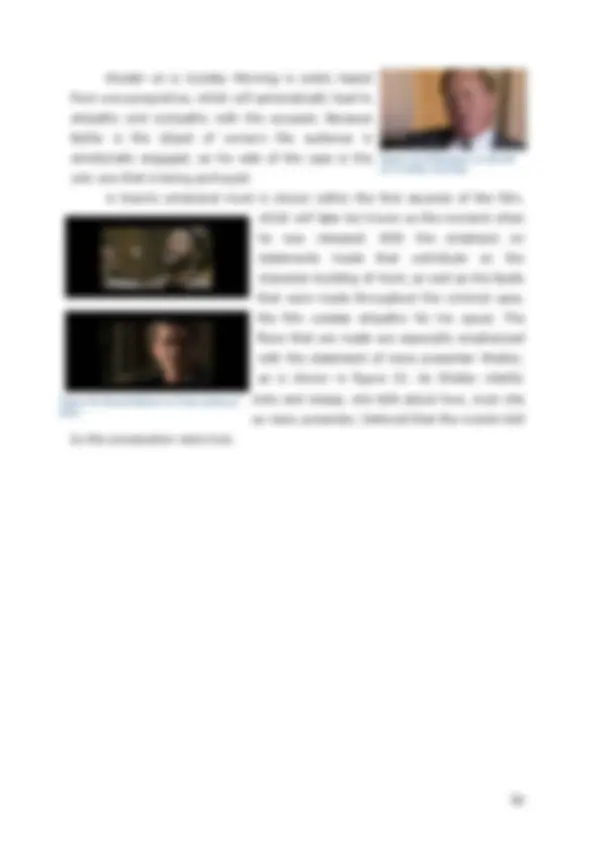
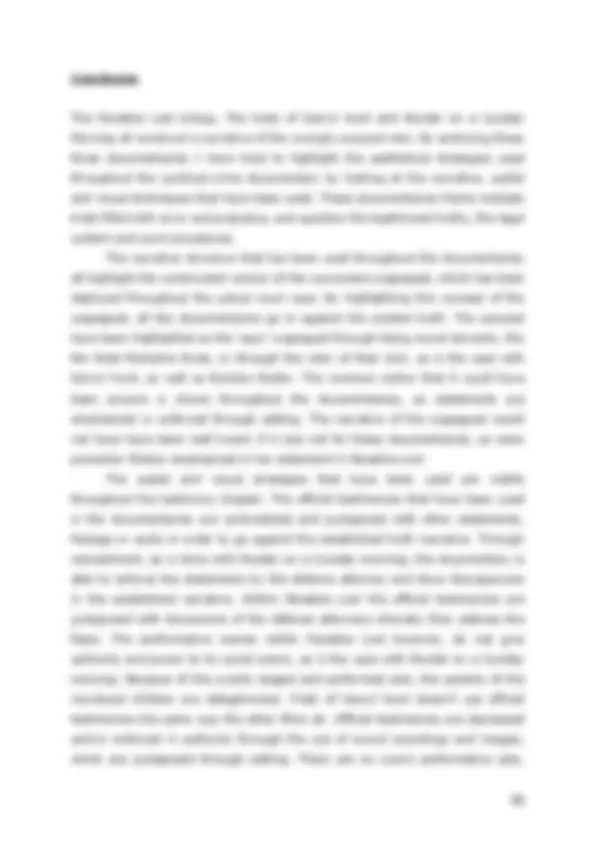
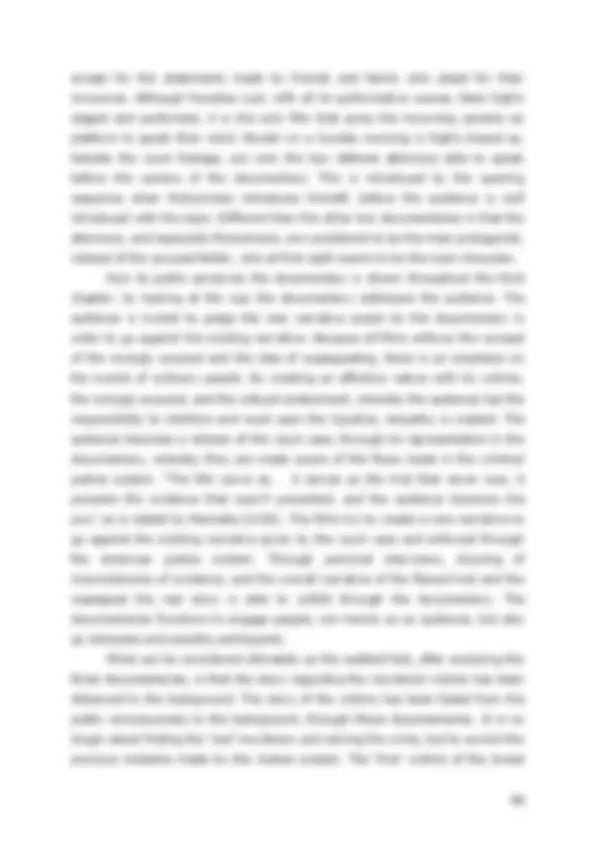

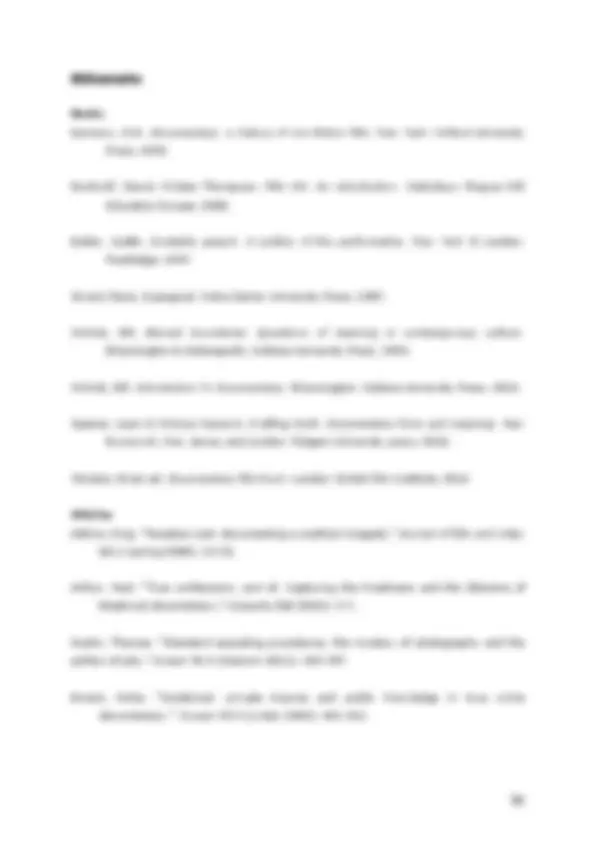
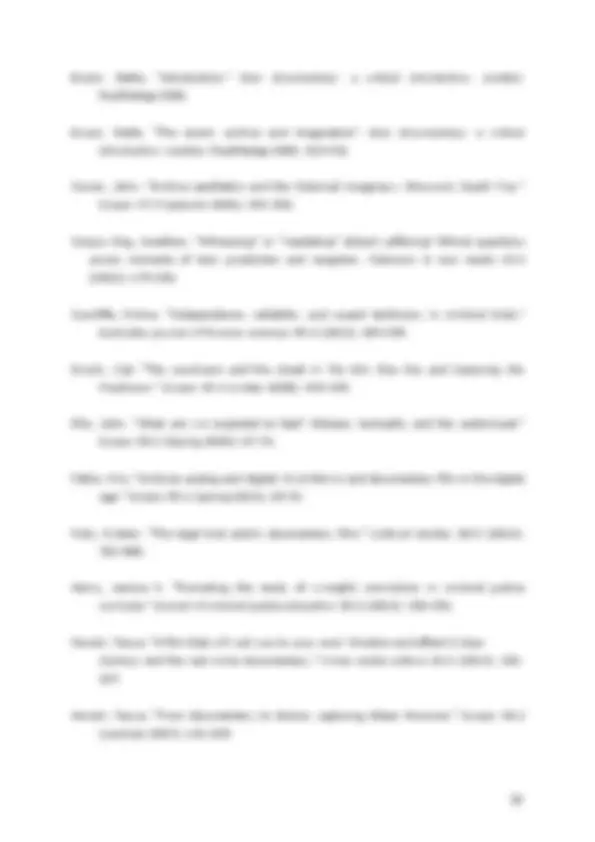
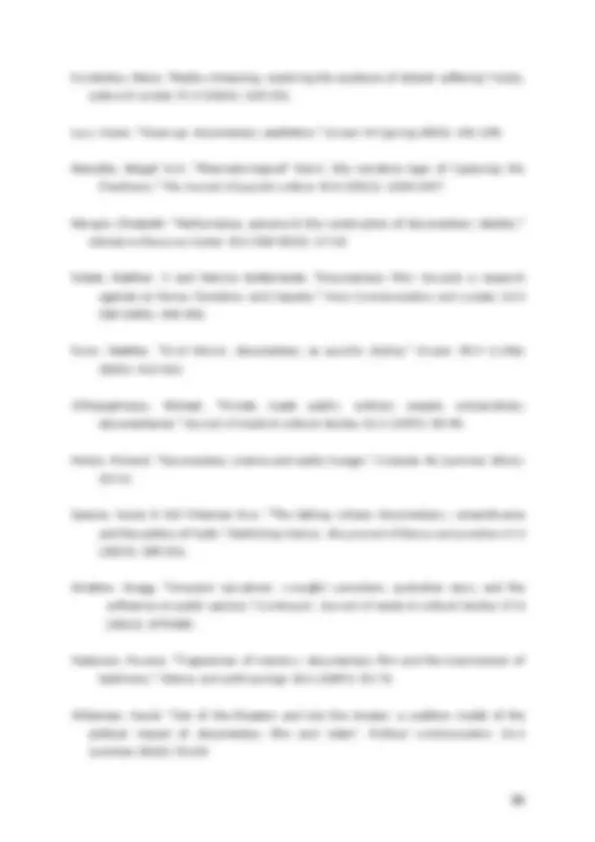
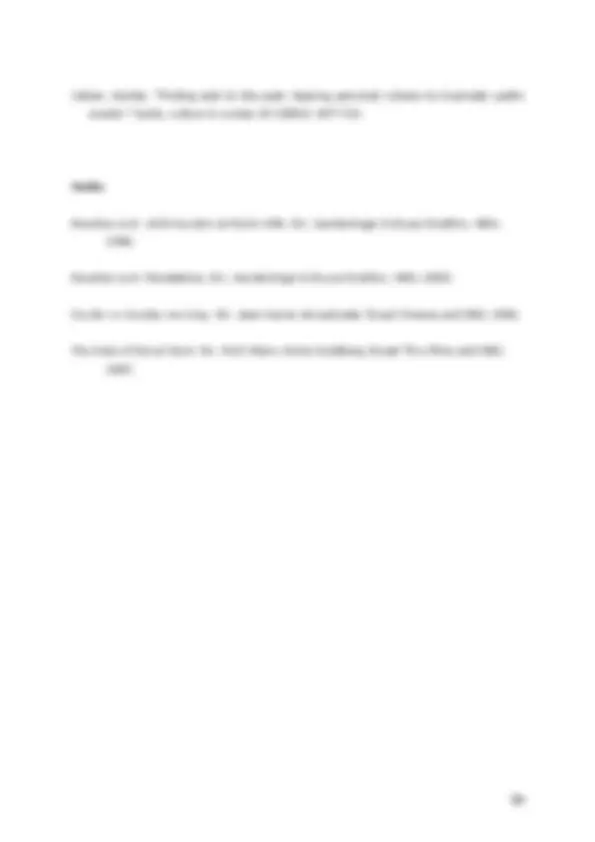


Study with the several resources on Docsity

Earn points by helping other students or get them with a premium plan


Prepare for your exams
Study with the several resources on Docsity

Earn points to download
Earn points by helping other students or get them with a premium plan
Community
Ask the community for help and clear up your study doubts
Discover the best universities in your country according to Docsity users
Free resources
Download our free guides on studying techniques, anxiety management strategies, and thesis advice from Docsity tutors
This thesis explores the construction of truth claims in crime-juridical documentaries, focusing on how aesthetic procedures like sound, image, narrative, editing, music, and camera use enable these films to present alternative truths. The research will analyze documentaries that question the represented truth in court cases and expand the understanding of the crime-juridical documentary genre.
What you will learn
Typology: Study notes
1 / 59

This page cannot be seen from the preview
Don't miss anything!




















































Master Thesis University of Amsterdam MA Television and Cross-media culture Supervisor: Markus Stauff Second reader: Toni Pape
Tanja Bliek 5824079
First Version: June 26 2015 Words: 19.
justice system, and the overall social problems within American society. By addressing these issues the documentaries want to bring public attention to the injustice of the wrongfully accused and possibly derive a different outcome within the crime cases. The question of truth is central to these documentaries and their pursuit of their subjects. This leads to ‘feeding a strong, cultural desire to access a terrible, unbelievable ‘real’, according to Horeck (151). Documentaries behold within them the implicit concept of an ultimate truth claim. Within this specific documentary genre, namely the crime-juridical documentary, the truth claim is even more important through their common goal of delivering and unveiling another version of the truth, by going against the established truth claim of the American justice system. The rise of the crime-drama-juridical documentary, with its specific goal of revisiting an established truth, is an especially interesting genre. In my thesis I want to look at the construction of true crime representations that lay claim to authenticity, and use films that question the represented truth in court cases. I am interested how these films can question the power of the American justice system and possible reinterpret/represent another narrative. Diverse aesthetic strategies and techniques are used in order to portray the criminal court cases, the convictions and the subsequent exonerations. Within this thesis I would like to research how different aesthetic procedures, like sound, image, narrative, editing, music and camera use, are being used throughout the documentaries and how they differ or bare similarities between the documentaries, by looking at the narrative structure, the presentation of evidence, pictures, archival footage and testimonies. I would like to research which strategies are used in combination with the concepts of the representation of evidence, narratives of injustice and visual spectacle. All these documentaries deal with the similar problems regarding the wrongly accused, but how is this represented through the documentaries? Do they all use the same approach, or do they convey different techniques and styles? How do aesthetic procedures enable documentaries to present an alternative truth? The Thin Blue Line has shown the possibility to present an alternative version of the truth and has countered the truth already established within the American justice system, through re-enactment. I want to expand the research on possibilities for the crime-juridical documentary to show these alternative
truths by looking at other documentaries within this genre (i.e. crime-juridical documentaries). I have chosen the documentaries Paradise Lost, Murder on a Sunday Morning and The trials of Darryl Hunt as they all show a different exoneration case. The documentaries that are employed throughout this thesis all behold the narrative of the wrongly accused, although from very different perspectives, angles and time periods. All the documentaries have received critical acclaim and media attention. The Paradise Lost trilogy consists of three different documentaries made by Joe Berlinger and Bruce Sinofsky; Child murders at Robin Hood Hills (1996) , Revelations (2000) and Purgatory (2011). Berlinger and Sinofsky have previous worked together on the critically acclaimed documentary Brother’s keeper (1992) and Metallica: Some kind of monster (2004). The Paradise Lost trilogy looks at the murder of three young boys; Christopher Buyers, Michael Moore and Stevie Branch in West Memphis, Arkansas. These murders lead to the imprisonment and conviction of three teenage boys; Damien Echols, Jessie Misskelley and Jason Baldwin, based on questionable evidence in the first documentary. Throughout the trilogy the innocence of the three convicted men is proven. The Paradise Lost series have received many prices, including several Emmy’s for outstanding informational programming and even an Oscar nomination. Through the work of Sinofsky and Berlinger the case of the West Memphis three has received tremendous attention especially after the release of the first film, which lead to many followers and has contributed to the media attention and ultimate exoneration of the convicted three, which they show explicitly in the second and third film. The Trials of Darry Hunt (2006), directed by Ricki Stern and Anne Sundberg, is a documentary regarding the wrongful conviction and 20 year incarceration of Darryl Hunt for his wrongful conviction of the murder of Deborah Sykes. The Trials of Darryl Hunt encompasses twenty years of cinematographic material until the release of Hunt in 2004, through the confession of the real killer Willard Brown. Stern and Sundberg have started filming from 1993, 10 years into the criminal trial, after they heard of the rumours of alleged innocence of Hunt. The Trials of Darryl Hunt was released two years after the acquittal of Darryl Hunt. Sundberg and Stern document the trials and tribulations that Darryl hunt had to endure during his twenty-year incarceration.
In the third and final chapter I will look at how the narrative works through and for its audience, by looking at the witnessing of suffering. By aligning four different forms of witnessing, of the audience, we can distinguish how the documentary is constructed in order to engage its viewers.
1). Narratives of injustice To analyse the way the narrative of the wrongly accused is deployed through juridical documentaries several theories regarding documentary aesthetics will be used. To introduce documentary narratives I will first look at the six elements that have been connected to the so-called flawed trial, as mentioned by Jessica Henry, to introduce the narrative surrounding the documentary of the wrongly accused. By going against the established narrative the documentary entails a certain truth claim within it. This will be elaborated by looking at the several different concepts by Bill Nichols, Roxana Waterson, Kristen Fuhs and Anita Biressi. Looking at the pharmako-logical panic and the inconvenient scapegoat, that are recognizable throughout the documentaries, will show how the court presented the established truth claim. Hereby I will argue that all the documentaries represent the narrative of the inconvenient scapegoat as is deployed throughout the court case, but that its employment can be quite different. The guiding principles will be Abigail G.H. Manzella and Rene Girard. In the final chapter I will look at how the narrative structure is build up throughout the documentaries. The narratological elements of the flawed trial will be connected to several concepts regarding documentary and its inherent truth claim.
1.1. Flawed Trial
In criminology there is a current discussion surrounding the concept of the flawed trial and the causes for this. In this chapter I will look at the several misconducts performed within a criminal case that can lead up to a flawed trial. “Promoting the study of wrongful convictions in criminal justice curricula” by Jessica Henry will be the main thread throughout this chapter. Henry is an associate professor in the department of justice studies, after serving as a public defender for 10 years, focusing on criminal law and procedures, death penalty
perspectives and wrongful convictions. She has stated six elements that are to be considered to be the main reasons for wrongful convictions within the United States. Documentaries have the power of proving the court cases and their convictions wrong by emphasising on the causes for the failed trail and the wrongful conviction. In this chapter I will be looking at how the juridical documentary film might use the legal trial to contest or reinforce the convictions, by looking at eyewitness misidentification, false confessions, unreliable science, governmental misconduct, informants and bad lawyering given by Jessica S. Henry as well as the National Registry of Exonerations and additions by Fuhs, Cunliffe and Stratton. The six elements of Henry will be addressed throughout the thesis to show how the flawed trial and wrongful convictions are represented through documentaries. I am interested in the narrative and its structure because the presented narrative in the documentary is able to break free from its established narrative (and therefore truth). By highlighting the six classifications of Henry I will be able to distinguish the discrepancies and flaws of the court trial, and by analysing the narrative and its narrative structure the countered truth is able to come to light. By emphasizing how the narrative is constructed, the different aesthetical strategies will come to light. “Since 1989, when DNA testing was first employed to establish innocence, there have been 1.133 known exonerations of men and women who were wrongly convicted”, according to the National Registry of Exonerations (Henry 236). This data represent only an unknown portion of the innocent people wrongly convicted and incarcerated. Currently the marker is at 1. exonerations, 451 more exonerations in less than two years 1. The National Registry of Exoneration (from now on to be called NRE) is a project of the university of Michigan Law School, founded in 2012, in collaboration with the centre on wrongful convictions a t the NorthWestern University School of Law. “They give out detailed information about every known exoneration in the United States since 1989 – cases in which a person was wrongly convicted of a crime and later cleared of all the charges based on new evidence of innocence (www.law.umich.edu) According to the NRE there are six contributing factors which leads to exonerations within murder trials; mistaken witness identification
considered to be guilty, which causes the investigation and court case to be guided by the presumption of guilt. Hereby new or existing evidence, leads and other possible theories are disregarded in order to sentence the assumed guilty person (Henry 241). The suspect is then subjected to an interrogation, full with psychological coercion. The specific tactics that are used within the interrogation are specifically effective with vulnerable suspects. These suspects, mostly with cognitive impairments, juveniles or the mentally ill, are considered to be highly susceptible to coercion, whereby the police contaminates the confession by suggesting certain facts or leading their story of events. “Contamination by the police irreparably alters the confession” (Henry 242). Unreliable science, or the lack of scientific evidence is another cause for wrongful convictions. The most current misconception regarding court cases is that everything is done accordingly to the scientific investigation within popular television shows, like CSI (2000), NCIS (2003), Criminal Minds (2005) and many more. Unfortunately this is not at all accurate, as many forensic staff and laboratories are underfunded, understaffed or under supervised (Henry 242). There are still complications and limitations within the analysis of forensic evidence. As the National Academy of science states “[w]ith the exception of nuclear DNA analysis … no forensic method has been rigorously shown to have the capacity to consistently, and with a high degree of certainty, demonstrate a connection between evidence and a specific individual or source.” (Henry 242) Official governmental misconduct looks at how the governmental instruments, the police and/or prosecution, have contributed to the process of a flawed trial. Police misconduct can constitute of bad investigation work, deliberately ignoring, altering or even manufacturing of evidence, employing improper identification techniques or the usage of physical violence. Henry states that through tunnel vision evidence is filtered to support a specific version of the case, to highlight the guilt of a suspect(s), while disregarding contradicting evidence (243). Prosecutorial misconduct is considered to be the (deliberate) wrongful choices made by the prosecution office, which may lead to a wrongful conviction. Henry mentions many forms that can be identified as prosecutorial misconduct such as; “tampering with, destroying, hiding or failing to disclose evidence; threatening, tampering or badgering witnesses; using false or misleading evidence; suborning perjury; displaying bias against the defendant or defense counsel; and improper conduct in the grand jury and the courtroom.”
(Henry 244) To analyse whether the police or the prosecution has made himself guilty of misconduct is to examine whether they have applied the appropriate methods and techniques during cases, as stated by Cunliffe (287). Inadequate legal defense and bad lawyering stands for the legal defense team of the accused. These are mostly considered to be the defense attorneys who are appointed to poor defendants to represent them in criminal cases. Henry calls attention to the most common problems with an appointed legal defense; “Defense lawyers are often overworked and overburdened, with staggering caseloads. As a result, defense lawyers may fail to properly investigate a case, call key witnesses, or adequately prepare for trial. Furthermore, public defenders and court-appointed attorneys have limited or no access to forensic testing and expert witnesses.” (245) Defense lawyers often do not have the money, time, or access to evidence or general experience to properly represent their clients in court cases. The six mentioned elements presented by Henry and The National Registry of Exoneration are all considered to be part of the concept of the flawed trial, whereby documentaries adjust the basic common thinking regarding the criminal justice system, by addressing the possible errors of that same system within the documentary. “Exoneration cases have altered the ways judges, lawyers, legislators, the public and scholars perceive the criminal system’s accuracy, according to Garret (Henry 237). Paradise Lost employs all the elements of the flawed trial as given by Henry. The eyewitness misidentification, false confession and false accusation and governmental misconduct are all of extreme importance throughout the documentaries. These are touched upon in the first documentary child murders at Robin Hood Hills, but are more and more elaborated upon with the second and third film. Eyewitness misidentification is central to this documentary, as the West Memphis Three are convicted through several misidentifications, by emphasizing the wrong misidentification and the accusations the documentary was able to gain attention and ultimately break free from the established narrative of the court. In the chapter regarding testimony I will show how the documentary discredits the given statements by the witnesses and police and enhances other statements through
Figure 1. False Accusation in Paradise Lost
audible, visual and narrative evidence, like editing, found footage and interviews, the documentaries are able to prove the court case wrong, by highlighting, emphasizing or diminishing certain details of the criminal trial.
1.2 Truth claim
Do you swear to tell the truth, the whole truth and nothing but the truth, so help you god? ( Paradise Lost: Child murders at Robin Hill)
Like court cases, documentaries behold within them the implicit characteristic of (re)telling the truth, as it has appeared. Documentaries always behold within them some sort of truth claim. This truth claim is based upon the notion that what appears on the screen is considered to be ‘real’. The notion of revealing the truth does not become apparent in every documentary, but is of great importance within the crime-juridical documentary genre. Documenting and representing the truth of the court cases seems to be the general truth claim within these documentaries. Telling the truth seems to be the most explicit and important thing in every court case but how has this principle of telling the truth before the court worked through the juridical-crime documentary? By looking at definitions given by Waterson, Nichols, Spence and Navarro, I will analysis the truth claim within the current juridical-crime documentary. “Documentary films speaks about situations and events involving real people (social actors) who present themselves to us as themselves in stories that convey a plausible proposal about, or perspective on, the lives, situations, and events portrayed. The distinct point of view of the filmmaker shapes this story into a way of seeing the historical world directly rather than into a fictional allegory” (14). This definition by Bill Nichols in his book Introduction into documentary shows the diversity surrounding the concept of documentary. An easier and shorter definition could be that ‘documentaries address or represent reality’. The definition of addressing and/or representing reality brings with it its own problems. Can reality ever be captured and or mediated through documentaries? Should we look at documentary as the ‘creative treatment of
reality’ as Grierson stated it, or should we be more aware of the constructed nature of film? Historically there have been different forms of documentary in representing the truth and reality. The definition of documentary has changed throughout its years and has known different forms and styles. Two main concepts have been essential throughout these years and I would like to argue that the juridical documentary uses and combines both these concepts in order to reveal their ‘ultimate truth.’ Direct Cinema and Cinema Verité are two cinematographic styles that have very different ideas, concepts, styles and techniques regarding capturing and representing the truth. Direct Cinema has emerged as early as the 1920’s. Within the Direct cinema style the camera observes and the documentary relies on editing to generate a sense of experience and time passing as Anita Biressi mentions in her article “Inside/out: private trauma and public knowledge in true crime documentary” (408). This movement uses the camera as a fly-on-the-wall , documenting without interference, as could be argued seems to be the case within the courtroom. The camera is merely used here to observe and record what is happening before its screen, waiting for a spectacular moment to unravel its self. Direct cinema is seen to come to light within the crime-juridical genre through its fly-on-the-wall technique deployed within the court room. Within the three different documentaries the fly-on-the-wall strategy is used within the court case enabling the audience of the documentary to witness the entire court case in one film, able to see connections and a narrative structure through the employment of editing. This footage can be filmed by the crew of the documentary, as is the case with Paradise Lost and Murder on a Sunday Morning , or can be borrowed from traditional news media, as The trials of Darryl Hunt does this. All the documentaries use this kind of court footage to record and represent the ‘ultimate truth’. Juridical documentaries derive their power and truth claim status from the implicit notion that everything that has happened before the camera is true and really happened, without interference. Only by using editing a sense of experience, time passed and narratological connections can be made. This is done within all the court cases as they switch between the actual court case and other footage, like found footage, pictures or testimonies before the camera.
highlighting a narrative of the scapegoat these films go against and countermand the existing power structure that is the American Justice System. The documentaries use the fly-on-the-wall technique in order to portray the court cases, whereby they can be considered to be part of the Direct Cinema movement. As is shown in figure 4, all documentaries employ the fly-on-the-wall technique within their documentaries.
Because these films offer footage that were shot during the actual trial they behold within them the truth claim of the actual event. The images that are shown have really occurred, although the documentary goes against its presented narrative. Through the use of journalistic interview, editing and performativity characteristics, part of the Cinema Verité , the documentaries are able to go against this presented narrative. Editing and the interviews are able to show the contradictions within the fly-on-the-wall footage, as is shown in figure
Figure 5. Interviews in Trials of Darryl Hunt, Paradise Lost & Murder on a Sunday Morning
In relation to the images of the actual court case they observe and document the process that reveals before them. Outside the court room, the documentaries interfere and interact with its social actors, whereby editing generates a specific sense of experience and time passing. Within the Testimony chapter I will look at how the Direct cinema techniques are employed throughout the documentaries, and within the Performativity chapter I will look more closely at the performative nature of the documentary itself and of its social actors. Hereby I can look at the influence that is made explicit throughout the documentaries by highlighting the presence of cameras and film crews or the usage of journalistic interview.
Figure 4. Court footage in Murder on a Sunday Morning, Trials of Darryl Hunt & Paradise Lost
The truth claim that documentaries represent go against the established version of the truth, whereby the suspects are classified as the scapegoats. In the next chapter I want to show that the documentaries show their own version of the truth by highlighting the concept of scapegoating. Its truth claim is established by going against the established truth claim.
1.3 Convenient Scapegoat
The question of truth, constructed through the court case and enhanced through the power structure of the American justice system, is questioned throughout these juridical documentaries by demonstrating the established elements and classifications of the flawed trial. These classifications demonstrate an alternative narrative and show the reasons for exonerations within the court cases. I would like to expand the already established elements by looking at the principle of the convenient Scapegoat and the pharmako - logical narrative. In this chapter I would like to argue that the truth conveyed by the Court case is not the ‘real truth’, which will be revealed by uncovering the scapegoat and pharmako-logical narrative. These documentaries show that a consistent use of the scapegoat narrative has been used throughout the different court cases and documentaries to undermine the ‘real’ truth to come out. The documentaries disclose a scapegoat narrative to undermine and question the authority of the court case and the established narrative. In this chapter I would like to look at the narrative structure that has built up around the narrative of the wrongly accused throughout documentaries. I would like to argue that documentaries, surrounding the narrative of the wrongly accused, all represent the idea of the convenient scapegoat. This concept has not been new within contemporary culture and thus existed before documentaries represented their stories audio-visually, but these documentaries are able to highlight how scapegoats were found and prosecuted at the time, focusing on the idea of the convenient scapegoat. The concept of the scapegoat has a twofold tension between the court and the film. The criminal justice system tries to apply this narrative on the actual case, and therefore on the accused, whereby the documentary tries to highlight the established scapegoat narrative and thereby to break free from its established concept of the scapegoat. The documentaries represent the court
The extensive writing of Rene Girard has inspired Manzella’s work. In his 1986 book The scapegoat Girard talks about the principle of the scapegoat and the hysteria of the public. Girard describes in his book how the desire for a scapegoat was developed wit the emergence and rise of the death by the black plague; “Their desire to deny the evidence contributed to their search for ‘scapegoats.” The fear for the black plague is no longer valid today but the desire for scapegoats has remained. Naming a scapegoat(s) has therefore two sides, that of the persecutor and the scapegoat him/herself. Persecution is built upon the conviction that the persecutors are and must be right, so therefore the accused must be guilty. According to Girard “If narrative describes circumstances favourable to persecution, if it presents us with victims of the type that persecutors usually choose, and if, in addition, it represents these victims as guilty of the type of crimes which persecutors normally attribute to their victims, then it is very likely that the persecution is real. If this reality is confirmed by the text itself there is little scope for doubt” (6). Because the accused have been presented as deviants and are on the margins of society, they must be capable of the crimes, therefore their accusation must be real. Within Paradise Lost the accused have been presented as being deviants from society and are presented as scapegoats, which are confirmed by the text itself. The text by which we can read this is the court case in which the prosecution is presented. The expert and witness testimonies confirm the text of the West Memphis Three being guilty of the crime, whereby the documentary of the court case can be seen as the “the trial it never was; it presents the evidence that wasn’t presented, and the audience becomes the jury’” (Manzella 1234). By putting emphasis on the pharmako-logical panic and the idea of the scapegoat the documentaries emphasize their inherent truth claim and the innocence of the accused. All employ the idea that the accused could have easily been someone else, although within some form of the margins of society. The films use a critical perspective on scapegoating to question the prosecution. The margins of society can constitute several different elements like poverty, sexual deviance, differing religious grounds, ethnicity, class or lifestyle. The collective fear within Paradise Lost is determined by the ‘satanic’, the ‘occult’ and ‘ritualistic killing’. Already a national fear at the time, as is made clear within the documentary by showing news reports and parts of popular television shows
like Oprah Winfrey, made it particularly easy to point to the suspects Echols, Misskelley and Baldwin as the obvious and easy scapegoats. As expressed by Manzella “the anger expressed both by the immediate community and by the nation in general focused on [sexuality], satanic, but various other factors contributing to the demonizing of the West Memphis three” (Manzella). The West Memphis Three have been demonized by emphasizing three different features, which considered them to be the deviant other(s) and through which they can be labelled as scapegoats. Firstly they are considered to be “white trash and freaks”. Being poor puts them at the financial bottom of society, but the lower financial status also beholds within it the judgement of a lower moral. The lowest (financial) class of society are seen as having a lower moral compass. The lower moral compass makes them more susceptible for committing horrendous crimes, as the ones committed at Robin Hills. Being on the border of society is also confirmed by the religious deviancy they portray by being Wicka followers. The several witness testimonies calling them “weird” or “freaks” are also based upon their religious difference, appearance and choice of music. Throughout the entire documentary can dark rock music be heard, to emphasize the musical preference of the boys. By distancing himself from the overall Christian beliefs of his community he is becoming a religious abnormality. Although Wicka is explained by Echols himself as an worshipping of nature; “It is basically a close involvement with nature” and mixture of different religions, Wicca seems to be compared to Satanism, although Satan is not recognized within the religion itself. What Wicca truly is does not even matter, the accusation and comparison with Satanism is believed by the jury and the overall public at the time because it suited the formulation of the Scapegoats. By enclosing the explanation of Echols regarding Wicca, the audience gets a different version of their religion, which doesn’t seem to be incorporated within the traditional media coverage. The appearance and musical preference of the West Memphis Three, especially Echols and Baldwin, adds to the already established idea of the scapegoat and reinforces it. As mother Pam Hobbs states in her testimony before the news camera, when she is asked if she believes that the people who did this
Figure 6. Echols in Paradise Lost